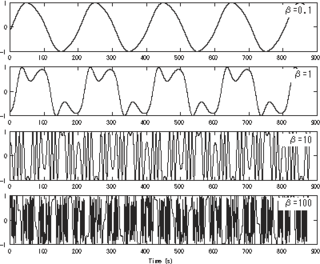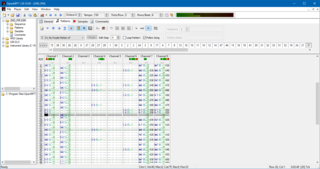
Frequency modulation synthesis is a form of sound synthesis whereby the frequency of a waveform is changed by modulating its frequency with a modulator. The (instantaneous) frequency of an oscillator is altered in accordance with the amplitude of a modulating signal.

A sound card is an internal expansion card that provides input and output of audio signals to and from a computer under the control of computer programs. The term sound card is also applied to external audio interfaces used for professional audio applications.

A music tracker is a type of music sequencer software for creating music. The music is represented as discrete musical notes positioned in several channels at chronological positions on a vertical timeline. A music tracker's user interface is traditionally number based. Notes, parameter changes, effects and other commands are entered with the keyboard into a grid of fixed time slots as codes consisting of letters, numbers and hexadecimal digits. Separate patterns have independent timelines; a complete song consists of a master list of repeated patterns.

Sound Blaster is a family of sound cards designed by Singaporean technology company Creative Technology. Sound Blaster is a brand of sound cards and audio peripherals developed by Creative Technology, a Singapore-based company. The first Sound Blaster card was introduced in 1989, and since then, the Sound Blaster brand has become synonymous with high-quality computer audio.

The MOS Technology 6581/8580 SID is the built-in programmable sound generator chip of the Commodore CBM-II, Commodore 64, Commodore 128, and MAX Machine home computers.

The SN76489 Digital Complex Sound Generator (DCSG) is a TTL-compatible programmable sound generator chip from Texas Instruments. Its main application was the generation of music and sound effects in game consoles, arcade games and home computers, competing with the similar General Instrument AY-3-8910.

POKEY, an acronym for Pot Keyboard Integrated Circuit, is a digital I/O chip designed by Doug Neubauer at Atari, Inc. for the Atari 8-bit family of home computers. It was first released with the Atari 400 and Atari 800 in 1979 and is included in all later models and the Atari 5200 console. POKEY combines functions for reading paddle controllers (potentiometers) and computer keyboards as well as sound generation and a source for pseudorandom numbers. It produces four voices of distinctive square wave audio, either as clear tones or modified with distortion settings. Neubauer also developed the Atari 8-bit killer application Star Raiders which makes use of POKEY features.
The Environmental Audio Extensions are a number of digital signal processing presets for audio, present in Creative Technology Sound Blaster sound cards starting with the Sound Blaster Live and the Creative NOMAD/Creative ZEN product lines. Due to the release of Windows Vista in 2007, which deprecated the DirectSound3D API that EAX was based on, Creative discouraged EAX implementation in favour of its OpenAL-based EFX equivalent – though at that point relatively few games used the API.

A voltage-controlled oscillator (VCO) is an electronic oscillator whose oscillation frequency is controlled by a voltage input. The applied input voltage determines the instantaneous oscillation frequency. Consequently, a VCO can be used for frequency modulation (FM) or phase modulation (PM) by applying a modulating signal to the control input. A VCO is also an integral part of a phase-locked loop. VCOs are used in synthesizers to generate a waveform whose pitch can be adjusted by a voltage determined by a musical keyboard or other input.
The digital sound revolution refers to the widespread adoption of digital audio technology in the computer industry beginning in the 1980s.
E-MU 20K is the commercial name for a line of audio chips by Creative Technology, commercially known as the Sound Blaster X-Fi chipset. The series comprises the E-MU 20K1 (CA20K1) and E-MU 20K2 (CA20K2) audio chips.

The AY-3-8910 is a 3-voice programmable sound generator (PSG) designed by General Instrument in 1978, initially for use with their 16-bit CP1610 or one of the PIC1650 series of 8-bit microcomputers. The AY-3-8910 and its variants were used in many arcade games—Konami's Gyruss contains five—and pinball machines as well as being the sound chip in the Intellivision and Vectrex video game consoles, and the Amstrad CPC, Oric-1, Colour Genie, Elektor TV Games Computer, MSX, and later ZX Spectrum home computers. It was also used in the Mockingboard and Cricket sound cards for the Apple II and the Speech/Sound Cartridge for the TRS-80 Color Computer.

Sound Blaster X-Fi is a lineup of sound cards in Creative Technology's Sound Blaster series.

The Ensoniq AudioPCI is a PCI-based sound card released in 1997. It was Ensoniq's last sound card product before they were acquired by Creative Technology. The card represented a shift in Ensoniq's market positioning. Whereas the Soundscape line had been made up primarily of low-volume high-end products full of features, the AudioPCI was designed to be a very simple, low-cost product to appeal to system OEMs and thus hopefully sell in mass quantities.

Sound Blaster Live! is a PCI add-on sound card from Creative Technology Limited for PCs. Moving from ISA to PCI allowed the card to dispense with onboard memory, storing digital samples in the computer's main memory and then accessing them in real time over the bus. This allowed for a much wider selection of, and longer playing, samples. It also included higher quality sound output at all levels, quadrophonic output, and a new MIDI synthesizer with 64 sampled voices. The Live! was introduced in August 1998 and variations on the design remained Creative's primary sound card line into the early 2000's.

Sound Blaster Audigy is a product line of sound cards from Creative Technology. The flagship model of the Audigy family used the EMU10K2 audio DSP, an improved version of the SB-Live's EMU10K1, while the value/SE editions were built with a less-expensive audio controller.

The Sound Blaster 16 is a series of sound cards by Creative Technology. They are add-on boards for PCs with an ISA or PCI slot.

SN76477 "complex sound generator" is a sound chip produced by Texas Instruments (TI). The chip came to market in 1978, and TI ceased production of the part. A compatible version is identified as ICS76477. The chip is typically used as a sound effects generator in arcade games and toys and for hobby projects. The use of the SN76477 in a musical context is limited by the fact that it was difficult to electronically control the pitch of the produced sound.
Throughout its lengthy, multi-model lifespan, the Apple II series computers lacked any serious built-in sound capabilities. At the time of its release in 1977, this did not distinguish it from its contemporaries, but by 1982, it shared the market with several sound-equipped competitors such as the Commodore 64, whose SID chip could produce sophisticated multi-timbral music and sound effects.
The OPL series are a family of sound chips developed by Yamaha. The OPL series are low-cost sound chips providing FM synthesis for use in computing, music and video game applications.














